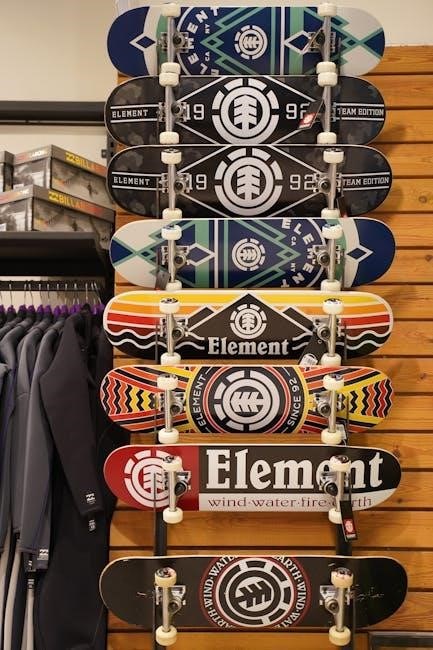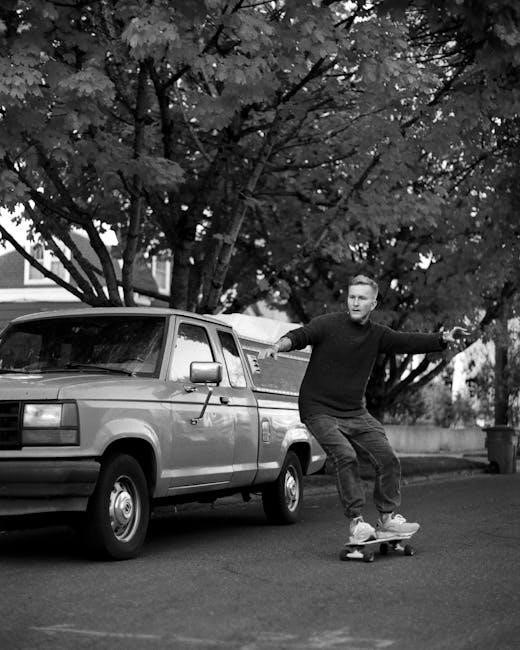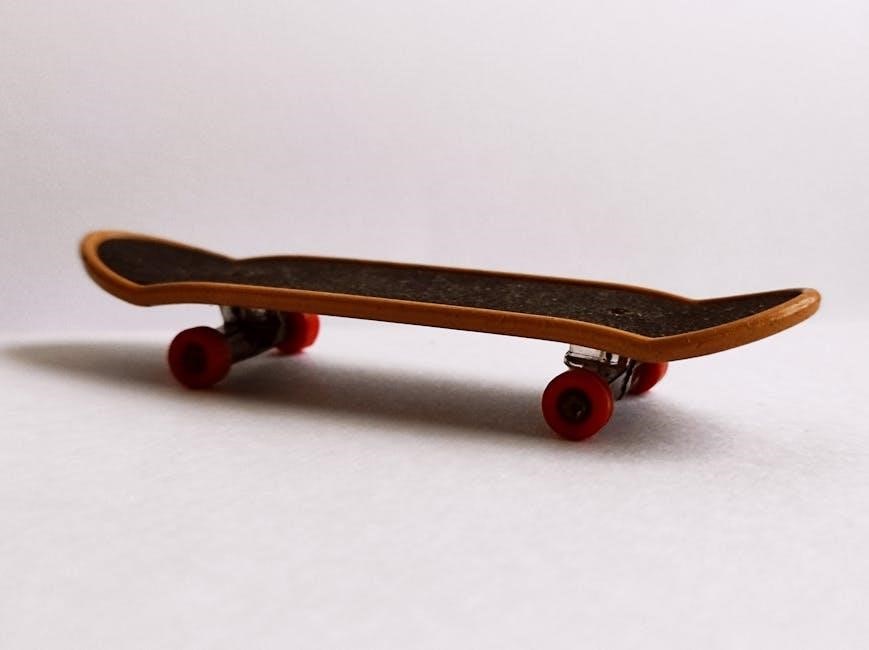Skateboard truck size significantly impacts performance and stability. Understanding axle width and deck compatibility is crucial. This guide covers truck measurements, compatibility, and selection tips for optimal skating.
1.1 Importance of Choosing the Right Truck Size
Choosing the right skateboard truck size is essential for optimal performance, stability, and control. Properly sized trucks ensure compatibility with your deck width, improving balance and maneuverability. Incorrect sizes can lead to poor stability, reduced performance, and increased risk of damage. Compatibility ensures even weight distribution and better response during tricks and cruising. Referencing size guides from brands like Krux or Ace helps match axle width to deck size, ensuring a smooth and safe skating experience.

1.2 Overview of Truck Measurements and Compatibility
Understanding truck measurements is crucial for compatibility with your skateboard deck. Axle width, hanger size, and kingpin placement are key factors. Trucks are measured by axle width, which must match the deck’s width for optimal performance. Standard sizes range from 7.6″ to 8.25″, with specific recommendations for deck widths. Compatibility ensures proper fitment, stability, and maneuverability. Always refer to brand-specific size guides, like Krux or Thunder, for accurate measurements and deck width pairing to ensure the best skating experience.

Understanding Truck Size and Deck Compatibility
Truck size and deck compatibility are crucial for optimal performance. Proper fitment ensures stability, control, and maneuverability. Improper sizing affects the skating experience and safety;
2.1 How Truck Width Relates to Deck Size
Truck width plays a critical role in skateboard performance, as it must align with the deck’s dimensions. A truck that is too wide or narrow disrupts balance and control. Proper fitment ensures the trucks’ hangers match the deck’s width, optimizing stability and maneuverability. For example, a 7.6″ deck pairs best with trucks like Independent 129 or Krux 7.6, while an 8.00″ deck suits Thunder 147 or Ace 22 trucks. Matching truck width to deck size is essential for a responsive and enjoyable ride.
2.2 Standard Truck Sizes and Their Recommended Deck Widths
Standard truck sizes are designed to complement specific deck widths, ensuring optimal performance. For decks under 7.75″, trucks like Independent 129, Thunder 145, or Krux 7.6 are ideal. Decks between 7.75″ and 8.25″ pair well with Independent 139, Thunder 147, or Ace 22 trucks. Larger decks (8.25″ and above) are best matched with wider trucks, such as Independent 149 or Thunder 149. Proper alignment ensures stability, control, and responsiveness for all skating styles.
Truck Size Charts and Recommendations
Consult size charts and guides from brands like Independent, Thunder, and Krux to match your deck width with the ideal truck size for optimal performance.
3.1 Popular Truck Brands and Their Size Guides
Top brands like Independent, Thunder, and Krux offer detailed size guides to help skaters choose the right trucks. Independent recommends trucks like the 129 for decks under 7.75″ and 139 for 8.00″ decks. Thunder suggests 145 trucks for narrower boards and 147 for wider ones. Krux provides axle widths from 7.6 to 8.25, catering to decks between 7.25″ and 8.50″. These guides ensure compatibility and optimal performance, making it easier to find the perfect fit for your setup.
3.2 Axle Width vs. Deck Size Compatibility
Axle width must align with deck size for optimal performance. A truck axle that’s too narrow for the deck can cause instability, while one that’s too wide may limit turning. Popular brands like Krux and Ace provide charts linking axle widths (e.g., 7.6″ to 8.25″) to suggested deck sizes (7.25″ to 8.50″). Proper compatibility ensures better stability, responsiveness, and control. Always match axle width to deck size for a smoother, more balanced ride, as mismatched setups can hinder skating performance and overall comfort.
Factors Influencing Truck Size Selection
Rider style, skating type, and personal preference significantly influence truck size selection. Street skating may require different setups compared to cruising or longboarding, affecting performance and comfort.
4.1 Rider Style and Preference
Rider style and preference play a key role in selecting truck size. Street skaters may favor narrower trucks for agility, while cruisers prefer wider trucks for stability. Personal comfort and skating technique also influence choices, as taller riders might opt for taller trucks. Deck width compatibility remains crucial, with size guides like Krux and Ace offering specific axle widths for various deck sizes. Ultimately, balancing performance needs with personal skating style ensures the best fit, enhancing overall control and maneuverability. Bushing hardness further tailors the ride to individual preferences.
4.2 Types of Skateboarding and Required Truck Sizes
Different skateboarding styles require specific truck sizes. Street skating often uses narrower trucks (7.6-8.0″) for agility, while cruiser boards prefer wider trucks (8.25-9.0″) for stability. Transition skating may opt for medium-width trucks (8.0-8.5″) to balance maneuverability and support. Bushing hardness also varies, with softer bushings suited for carving and harder ones for high-speed stability. Selecting the right truck size based on skateboarding type ensures optimal performance, control, and a personalized skating experience.
Measuring Your Current Setup
Measuring your skateboard setup involves determining deck width and truck axle width. Use a ruler to accurately measure these dimensions for proper fit and performance.
5.1 How to Measure Your Skateboard Deck
To measure your skateboard deck, place the ruler or tape measure across the deck’s width at its midpoint. Ensure the measurement is taken from edge to edge. Record the width in inches, as this determines the appropriate truck size. Double-check your measurement for accuracy. Deck width is crucial for ensuring proper compatibility with your trucks, as mismatched sizes can affect stability and performance. Always measure the deck before selecting trucks to guarantee the best fit for your setup.

5.2 How to Measure Your Trucks
To measure your trucks, start by placing them on a flat surface. Use a ruler or caliper to measure the axle width, which is the distance between the two outer bolts. This measurement is critical for determining compatibility with your deck. Next, measure the hanger width by placing the ruler across the top of the hanger, excluding the bushings. Record both measurements to compare with deck widths and ensure proper alignment. Accurate truck measurements are essential for maintaining stability and optimal performance while skating.
Common Mistakes to Avoid
Choosing trucks that don’t fit your deck size or riding style can lead to poor stability and performance. Always measure accurately and avoid guessing sizes.
6.1 Choosing Trucks That Are Too Wide or Too Narrow
Choosing trucks that are too wide or too narrow for your deck can lead to poor stability and maneuverability. Trucks that are too wide may cause the wheels to stick out, while narrow trucks can result in a loss of control. Always ensure the truck width matches your deck size for optimal performance and safety.
Referencing size charts and manufacturer guidelines can help avoid this common mistake. Properly fitted trucks enhance riding comfort and responsiveness, making it essential to measure accurately before purchasing.
6.2 Ignoring the Importance of Axle Width
Overlooking axle width can lead to poor stability and performance. A mismatched axle width disrupts the balance between the deck and trucks, affecting turning and grinding. If the axle is too wide, it may cause the wheels to protrude, risking damage. Conversely, a narrow axle can limit control. Always consult size charts to ensure proper axle-to-deck alignment, as this directly impacts ride quality and maneuverability. Neglecting this detail can result in a less responsive and less enjoyable skateboarding experience.

Advanced Considerations
Truck height affects stability and pop. Kingpin types and hanger designs influence turning and control. These factors enhance performance for advanced skaters seeking precise maneuverability and responsiveness.
7;1 Truck Height and Its Impact on Performance
Truck height significantly influences skateboard performance by affecting stability, control, and maneuverability. Lower trucks provide a lower center of gravity, enhancing stability and making tricks easier, while taller trucks offer more ground clearance, reducing wheel bite and accommodating larger wheels. The interaction between truck height, wheel size, and deck width is crucial for optimal performance, balancing factors like responsiveness, ride smoothness, and suitability for various skating styles. Proper truck height selection ensures a harmonious blend of these elements for an enhanced skating experience.
7.2 Kingpin and Hanger Types
Kingpin and hanger types play a crucial role in truck performance; Kingpins vary in size and grade, with heavier-duty options offering greater durability. Hangers come in different shapes and materials, affecting turning radius and stability. Standard kingpins are universal, while specialized ones optimize specific trucks. Hanger designs, such as forged or cast, influence weight and strength; Both components must align with deck and wheel setups for optimal functionality. Choosing the right combination ensures smooth turning, durability, and compatibility with your skating style and board configuration.

Bushing Hardness and Its Role
Bushing hardness directly affects ride quality and stability. Softer bushings provide better cushioning, while harder ones offer more stability. Proper hardness ensures optimal truck performance and control.
8.1 How Bushing Hardness Affects Ride Quality
Bushing hardness plays a crucial role in determining ride quality. Softer bushings provide better cushioning and flexibility, making them ideal for carving and turning. Harder bushings, on the other hand, offer stability and responsiveness, which are essential for high-speed skating and tricks. The right hardness ensures optimal performance, handling, and control, allowing riders to customize their setup based on personal preference, skating style, and weight.
8.2 Choosing the Right Bushing for Your Truck Size
Choosing the right bushing for your truck size ensures optimal performance. Bushings come in various hardness levels, and their size must match your truck’s axle width. Softer bushings suit smaller riders or those prioritizing flexibility, while harder bushings are ideal for heavier riders or high-speed skating. Popular brands like Bones and Riptide offer bushings tailored to specific truck sizes. Proper bushing fitment enhances stability, turning responsiveness, and overall ride comfort, ensuring your setup aligns with your skating style and preferences.
Selecting the right skateboard truck size is crucial for optimal performance, stability, and overall skating experience. Always consult size charts and consider your personal skating style.
9.1 Final Tips for Selecting the Perfect Truck Size
Always measure your deck width accurately and match it with compatible truck sizes. Consider your skating style and preferred terrain. For street skating, narrower trucks are ideal, while cruiser boards benefit from wider ones. Refer to size charts from brands like Krux or Ace for precise fits. Avoid trucks that are too wide or narrow for your deck to ensure stability. Test your setup and adjust if needed for optimal performance and comfort.